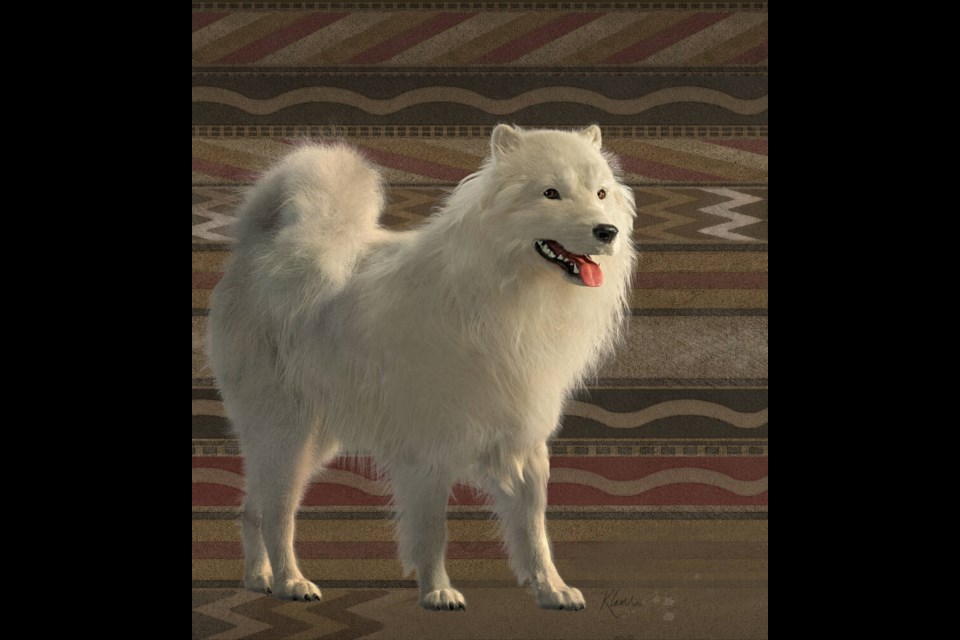The Coast Salish woolly dog, extinct for more than a century, was a unique breed that was carefully managed for thousands of years by First Nations for its fibre, which was used for blankets and clothing, according to a new genetic study by the Smithsonian Museum of Natural History.
The woolly dogs were kept isolated on small islands in pens and long houses throughout the Pacific Northwest, including Vancouver Island, to preserve the breed and prevent mixing with village and hunting dogs.
Anthropologist Logan Kistler and molecular biologist Audrey Lin analyzed genetic samples preserved in the pelt of a woolly dog named Mutton, the only known fleece in the world, stored at the Smithsonian, to pinpoint the genes responsible for the valued fibre.
The genetic data shows the woolly dog diverged from other breeds up to 5,000 years ago, aligning with archeological remains discovered throughout Vancouver Island and Pacific Northwest and far up the Fraser River.
Mutton’s pelt came from a naturalist working on a team establishing the Canadian-U.S. boundary in 1859. The dog’s DNA showed 85% of his ancestry could be linked to pre-colonial dogs.
A natural history illustrator created a reconstruction of what Mutton might have looked like in the 1850s: It stood knee-high and had white or light brown hair.
The genetic study included interviews with several Coast Salish people, such as elders and master weavers, who provided input on the role woolly dogs played.
Iain McKechnie, a coastal archaeologist at the University of Victoria, was the only bone scientist in the study, the findings of which were published this week in the journal Science.
“Coast Salish traditional perspective was the entire context for understanding the study’s findings,” said Kistler, curator of archeobotany and archeogenomics at the Washington, D.C.-based Museum of Natural History at the Smithsonian.
Liz Hammond-Kaarremaa, retired research associate at Vancouver Island University and a contributor to the study as an expert in historic textiles, said the research was a case of “science finally catching up to widely known First Nations oral history and proving it.”
She said Nanaimo First Nations traded regularly with Lower Mainland nations “equal bales” of dog wool for mountain goat fibre, and the practice extended south to nations in the Victoria and Sidney areas who also kept woolly dogs. Hammond-Kaarremaa said First Nations knew how to spin wool into yarn.
Eliot White-Hill of the Snuneymuxw First Nation said the woolly dog played a significant role in his nation’s history and culture.
A rock outcropping in downtown Nanaimo named Cameron Island was known as Sqwiqwi’, meaning the Place of Little Wool Dog, where the dogs were kept and cared for near the Snuneymuxw village site.
White-Hill said the dogs were revered and passed down from mothers to daughters, who managed breeding and did the shearing and weaving.
“They were sheared like sheep and the wool was woven into blankets,” said White-Hill. “Blankets were like a currency in our economy prior to contact and some of the most important things you could own and give away as gifts.”
Violet Elliott, also of the Snuneymuxw, said blankets made from fibres of woolly dog and mountain goat — acquired through trading with Lower Mainland nations — played an integral role in gatherings of nations from what is now Vancouver Island, Washington state and the B.C. mainland for naming ceremonies and weddings long before settlers ever landed.
“These dogs were cherished and our ancestors did everything we could to keep them separate from other dogs,” said Elliot, who comes from a long line of weavers. Her grandfather told her that before the 1800s, an ancestor was creating so many woolly dog blankets that they had the nickname Cuqnwtun, translated as Blanket Pin, the carved wooden pins that hold blankets together while weaving.
Elliot called the genetic study by the Smithsonian “an early Christmas present.”
“It brought a large group of people together that reaffirmed for us the history we know,” she said. “It was a gift of collaboration with other nations.”
It isn’t clear what led to the demise of the woolly dog — Mutton’s genetics told the researchers little about what caused the dogs to decline and disappear. Some speculate the arrival of Hudson’s Bay Company blankets in the early 19th century made woolly dogs expendable.
But Michael Pavel, an elder with the Skokomish Nation in Washington who was involved in the study, said it’s unlikely such a central part of Coast Salish society could be replaced by machine-made blankets.
Pavel and others suggest woolly dogs were probably doomed by several factors after European settlers arrived, including smallpox epidemics, influxes of miners during the 1858 Gold Rush and colonial policies that forced assimilation and displacement.
The study said the Indian Act of 1876 played a role because it prohibited Indigenous women — chief caretakers of the woolly dogs — from participating in local governance and restricted their movements. Mandatory residential schooling that removed children from their families also disrupted “knowledge transfers” about dog husbandry and weaving, the report said.
Sto:lo elder Rena Point Bolton, 95, recalls how her great-grandmother had kept woolly dogs, but was forced to give them up: “They were told they couldn’t do their cultural things. There was the police, the Indian agent and the priests. The dogs were not allowed. She had to get rid of the dogs.”
Eliot-Hill, 28, an artist who is working with elder Gary Manson on a children’s book on the woolly dog, has no doubt the culprit was colonization and assimilation, saying the dogs were likely outlawed like potlatch ceremonies and possibly exterminated in some villages.
Lin said the loss of the woolly dogs was swift. “It was thousands of years of very careful maintenance lost within a couple of generations,” she said. She noted that Mutton lived decades after the introduction of European dog breeds, which means Coast Salish communities likely continued to maintain woolly dogs’ unique genetic makeup until right before the dogs were wiped out.



